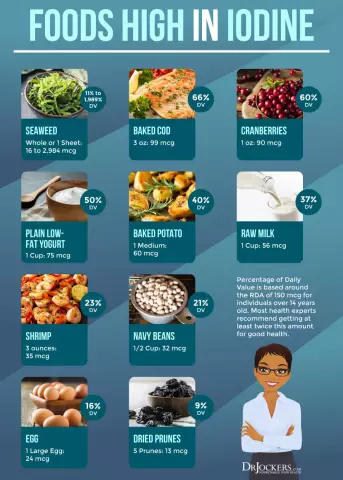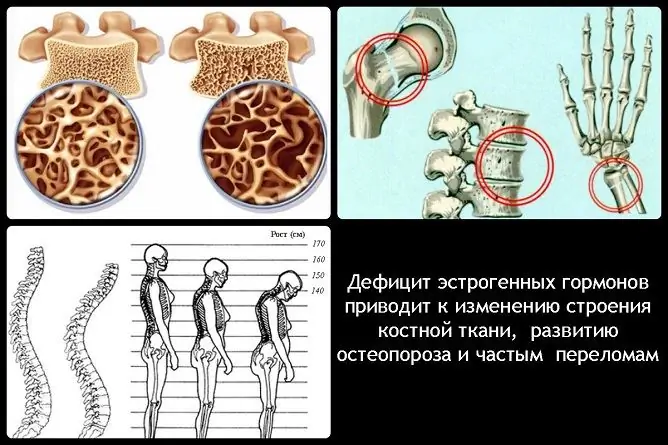- Author Rachel Wainwright [email protected].
- Public 2023-12-15 07:39.
- Last modified 2025-11-02 20:14.
Symptoms of excess female hormones estrogen
The content of the article:
- Symptoms of elevated estrogen in women
- Treatment
- What is estrogen hormone responsible for in women?
- Normal values of the content of estradiol in the blood
-
Why estrogens can be elevated in women
- Endogenous causes
- Exogenous causes
- Video
Symptoms of excess female hormones (estrogens) indicate the need to see a doctor, get tested and, if necessary, start therapy.
Estrogens is a subclass of steroid female sex hormones, which are secreted mainly by the follicular apparatus of the ovaries in women from androgens as a result of enzymatic reactions.
Although estrogens are important female sex hormones, they are present in the body of both sexes, but in different quantities. In men, they are much less, they are produced by the testes, and in both sexes they can be produced by adipose tissue, brain, skin, as well as in bones, hair follicles and in some other tissues.

Estrogens are the main female hormones, their excess causes a serious imbalance in the body
Estrogens include estradiol, estriol, and estrone. They perform similar functions, but have different effectiveness.
Symptoms of elevated estrogen in women
Excess female steroid hormones are among the causes of irregular menstrual periods. With an increase in estrogen and a decrease in progesterone, the mammary glands become more sensitive to the action of stimuli.
Hormonal fluctuations contribute to the development of headaches (including migraines). Before puberty, migraines develop in boys and girls with approximately the same frequency, after puberty in women, they are observed about 3 times more often.
When female sex hormones exceed the norm, the patient may experience:
- unmotivated increase in body weight (especially in the pelvic region);
- pain in the mammary glands (especially in the nipple area);
- swelling of the breast outside of menstruation and pregnancy;
- partial keratinization and desquamation of the epithelium in the vagina;
- swelling and / or coldness of the upper and lower extremities, heaviness in the legs;
- bloating;
- nausea;
- anxiety, unreasonable anger, panic attacks;
- depressive conditions;
- memory impairment;
- darkening in the eyes, dizziness, fainting.
Also, with an increased level of estradiol in the blood and a reduced concentration of prolactin, women may experience increased hair loss, insomnia, a tendency to blood thickening and thrombosis. This condition can lead to cancer of the uterus, breast, proliferation of endometrial cells (endometriosis), arterial hypertension and a number of other pathologies.
Treatment
Hormone therapy is usually used to lower estrogen levels. Patients can be prescribed anti-estrogen drugs, progesterone preparations. To maintain the normal level of hormones, the body needs B vitamins (especially B 6), magnesium, zinc.
To normalize estrogen levels, it is recommended:
- adjust weight;
- avoid exposure to xenoestrogens (substances that have an estrogenic effect in the body), which are part of some cosmetics, plastics, contraceptives;
- avoid stressful situations;
- normalize the daily routine, adhere to an adequate mode of work and rest;
- to refuse from bad habits;
- provide adequate physical activity;
- eat right, include foods rich in antioxidants and vitamins in the diet.
In some cases, complex treatment is required, aimed, for example, at normalizing the function of the thyroid gland and other endocrine organs.
What is estrogen hormone responsible for in women?
Estrogens have a feminizing effect on the body. So, these biologically active substances take part in the formation of female-type secondary sexual characteristics, the development of the vagina, uterus and fallopian tubes, ducts and stroma of the mammary glands.
Target organs for estrogen include:
- vagina;
- uterus;
- urethra;
- mammary gland;
- pituitary;
- hypothalamus;
- liver.
These organs have specific receptors that interact with estrogens.
Estrogens play an important role in ensuring the onset of conception and the normal course of pregnancy, as well as the functioning of the mammary glands, the absorption of calcium, the even distribution of subcutaneous fatty tissue, affect the condition of the hair, skin, nails, and take part in the restoration of bones.
Under their influence occurs:
- Increased blood levels of iron, copper and thyroxine.
- Increasing the concentration of high density lipoproteins, reducing the level of low density lipoproteins and total cholesterol, which reduces the risk of developing cardiovascular pathologies.
- Compensatory water and sodium retention in the body.
A decrease in the level of estrogen in the blood with the onset of menopause in women leads to the development of sleep and thermoregulation disorders, atrophy of the reproductive system, osteoporosis. Hormonal deficiency leads to an increased risk of cardiovascular disease, vaginal dryness, and decreased libido.

It is impossible to determine the excess of estrogen by symptoms, a laboratory test is necessary
Normal values of the content of estradiol in the blood
Estradiol is the main, most active of the three female sex hormones in this group. Daily fluctuations in the level of estradiol in the blood depend on the rhythm of secretion of luteinizing hormone (the maximum concentration is between 15:00 and 18:00, the minimum level is between 00:00 and 02:00). In addition, the content of estradiol in the blood varies depending on the phase of the menstrual cycle, as it correlates with the degree of maturation of the ovarian follicle.
The rates of estradiol for women are presented in the table.
| Period | Reference values |
| Follicular phase | 19.5-144.2 pg / ml |
| The middle of the menstrual cycle | 63.9-356.7 pg / ml |
| Luteal phase | 37.0-280.0 pg / ml |
| Postmenopause | Up to 32.2 pg / ml |
Normal values, research methods and rules for preparing for the delivery of the analysis may differ in different laboratories.
Why estrogens can be elevated in women
A woman's hormonal background changes throughout her life (pubertal period, pregnancy and lactation, menopause). After the onset of menopause, the body's production of estradiol decreases, and estrone takes the place of the main sex hormone.
According to statistics, an increased level of these substances is observed in about 50% of females 35 years and older. The reasons for an excess of estrogen in the body can be endogenous (excessive production of these hormones) and exogenous (obtained from the external environment).
Endogenous causes
Internal factors that can lead to an increase in the concentration of female sex hormones include:
- overweight and obesity;
- endocrine diseases;
- infectious and inflammatory diseases of the genital organs;
- diabetes;
- high blood pressure;
- heart disease;
- alcohol abuse;
- frequently occurring stressful situations.
Exogenous causes
An increase can occur during hormone replacement therapy, mainly when using drugs in the form of tablets or injectable solutions, i.e., general therapy. Local hormone replacement therapy (the use of suppositories, creams, etc.) is usually devoid of this side effect.
Some household chemicals, cosmetics, carpets, plastics, and furniture contain chemicals that mimic estrogen, which can lead to weight gain, which in turn can increase the production of biologically active substances. Certain foods (such as soy) are high in phytoestrogens and are also found in beer.
Video
We offer for viewing a video on the topic of the article.

Anna Aksenova Medical journalist About the author
Education: 2004-2007 "First Kiev Medical College" specialty "Laboratory Diagnostics".
Found a mistake in the text? Select it and press Ctrl + Enter.






